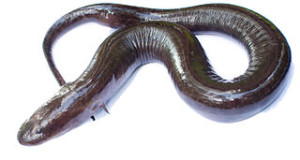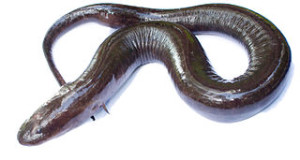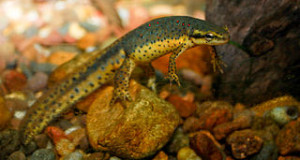Click here: The Natural History and Captive Care of the Mexican Axolotl, Ambystoma mexicanum: Natural History – Part 1, to read the first part of this article.
Diet
 Mexican axolotls feed upon shrimp, aquatic worms, copepods, insects and other invertebrates and small fish. Adults are major predators upon small axolotls and axolotl eggs. The larvae are largely carnivorous, but may consume some algae as well.
Mexican axolotls feed upon shrimp, aquatic worms, copepods, insects and other invertebrates and small fish. Adults are major predators upon small axolotls and axolotl eggs. The larvae are largely carnivorous, but may consume some algae as well.
Their main predators are herons and other wading birds, fishes and larger axolotls.
Reproduction
Males deposit spermatophores (sperm-filled capsules) on the lake bottom from March through June. After nudging the cloacal region of a gravid female – and being nudged in return – the male undulates his tail in front of her, most likely releasing pheromones (chemical attractants) in the process. He then leads the female over the spermatophore, which is taken into her cloaca. Fertilization occurs internally. The eggs, 100-300 in number, are laid after a gestation period of 2 weeks. They are attached to aquatic vegetation and hatch in 10-14 days.
The young reach sexual maturity in approximately 18 months. The Mexican axolotl is a paedormorphic (or neotenic) salamander, meaning that it retains a number of larval characteristics, including external gills (adults have lungs as well) and an aquatic lifestyle. Animals injected with the thyroid gland hormone thyroxin will transform into terrestrial adults, but do not survive for long.
Economic Importance
The Mexican axolotl is an ideal laboratory subject, and quite important in medical research. Studies of it have led to important advances many fields, including gene expression, neurobiology and limb/organ regeneration.
Axolotls possess a greater facility for regeneration than do most amphibians, and can re-grow limbs, digits, gills, tails and portions of the liver, spleen and eye. This ability may have important implications for people, and has been under investigation for some time.
Miscellaneous
Nearly all axolotls in captivity today can trace their origins to specimens collected from Lake Xochimilco and shipped to Paris in 1864. Three aquatic salamanders in the Genus Ambystoma have historically shared this species’ habitat, and it is believed that hybridization with these occurred at the time of that original collection. Current lab and pet populations may, therefore, differ genetically from wild axolotls.
The axolotl is closely related to the tiger salamander (A. tigrinum), and hybrids are fertile. Tiger salamanders also exist in neotenic form in certain populations. There is evidence that the animals forming the basis of today’s captive stock have interbred with neotenic tiger salamanders.
The name “axolotl” is taken from that of the Aztec god Xolotl, who was believed to have taken on the animal’s form, and loosely translates to terms such as “water dog”, water sprite”, “water slave” and “water monstrosity”.
I have written articles about axolotl relatives as well. Please see:
The Spotted Salamander, Ambystoma maculatum – Part I and Part II
Algae and Salamander Eggs – an odd partnership
The abstract of an International Zoo Yearbook article detailing the use of the axolotl as a “flagship species” for the conservation of its habitat is posted at:
http://www.ingentaconnect.com/content/bpl/izy/2008/00000042/00000001/art00014;jsessionid=1hpc0rtn02l2l.alexandra?format=print
 That Reptile Blog – Reptile, Amphibian and Exotic Pet Care and Information
That Reptile Blog – Reptile, Amphibian and Exotic Pet Care and Information




Hi, I have been looking at axolotls in my local pet store. The owner claims there have been no health problems at all, even though his store averages in the high 70’s ..i noticed your article mentions that this may be bad for them. I may be able to keep them in a basement where it is pretty cool, but ‘m concerned about buying them in case they may be in bad shape. Any advice would be great. I have a 20 gallon aquarium..could you suggest a filter if I do get them? Also, which product would be best of those you recommended as a main diet? Thank you.
Hello, Frank Indiviglio here. Thanks for your interest in our blog.
You’re quite right…the usual pet store temperatures are too high for axolotls. they do best when kept below 70F. Some do adjust however, and in the short term they may be fine. Before purchasing, check the skin carefully for patches of grey or white fungus, make sure they are moving about on the bottom normally and not floating, and ask to see them feed if possible.
If the water temperature in your basement differs by more than 10F from that of the pet store, acclimatize the axolotls by first setting them up in water of the same temperature as they have been kept in (i.e. warm the water with a heater if they are to be kept in a basement as you describe). Unplug the heater and allow the water to drop to room temperature while they are in the tank…in a 20 gallon aquarium, the change will be proceed at a safe pace (a quick change will stress their systems…as with fish , amphibians are prone to ick and similar parasitic infections in such situations).
Reptomin Floating Food Sticks are a good basic food for axolotls. Adults can be fed 2-3x per week, 2-3 food sticks per feeding. Feed live earthworms and/or blackworms every 7-10 days (more often is fine also); Hikari Massivore Diet should be offered at similar intervals. Live minnows, guppies should be provided once every 4 weeks or so. Use crickets and waxworms sparingly, not more than once monthly.
Filtration should be via a strong external power or canister filter. Axolotls are not strong swimmers; adjust the return flow so as not to disturb them. Partial water changes are important, even with effective filtration (25% each 2 weeks or 50% monthly for 2
animals in a 20 gallon aquarium is a good starting point).
I’ll post additions to the article you referenced shortly…please be in touch if you need further information before then.
Best regards, Frank Indiviglio.
Hi, We live in Australia and we are in the middle of a heat wave. I am finding it very difficult to keep the water temperature down under 20 degrees c. We are putting ice bricks in every half hour and still have only managed to get it down to 18.4 degrees c. It has not eaten for 4 days now as the water had gotten as high as 27 degrees c. I am suprised and very glad that it hasn’t died with that extreem heat shock. I would be grateful for any assistance in keeping the temp down please. Thanks
Hello, Frank Indiviglio here. Thanks for your interest in our blog .
My zoo contacts in Australia tell me that they also have trouble with non-native amphibians. There are a few things you can try, however.
As an emergency measure, you can keep the axolotl in your refrigerator. Keep it in as large a container as possible (so that the water cools slowly) and allow the water to drop in temperature on its own…the rate should be slow enough so as to prevent any sort of temperature shock. The animal will not need to feed once the temperature has bottomed out, but this will not be a problem as its metabolism will be operating very slowly at that point. Let me know how long the extreme warm temperatures generally last…I’ll make other suggestions if it will be long term (don’t feed the animal before putting it into the refrigerator).
Some people living in warm climates buy “mini refrigerators” in which to house amphibians permanently…the advantage is that you can raise the temps above food-storage temperature, yet keep it below the home’s ambient.
Do you have “artificial ice blocks” available…the plastic devices that you pre-freeze and use in coolers, etc.?…these may last longer than natural ice.
You might also try keeping the axolotl in a plastic storage container within a large cooler packed with real or artificial ice…a friend maintained a red salamander (Plethonodon rubber) in that way for 15 years. You’ll need to watch the temperatures closely at first, but with care you should be able to keep it at a temperature where the animal can feed, etc.
For long term care, you might also wish to consider a small aquarium chiller.
Good luck, Please let me know how it goes,
Best regards, Frank Indiviglio.
Thanks so much for your help. The artificial ice blocks are what we have been using. Small ones, big ones and lots of them, they float and thaw out pretty quick. We found a turkey breast cryovaced in the freezer and put that in and it sank to the bottom. Cooled the tank down to 16.8c and it ate for the first time in 4 days. We left that in overnight however when we woke up this morning the temp was back up to 22c. If the temp can rise that much overnight you can only imagine how quickly it can rise in the day. We are expecting 43c temps here today so I will keep a very close eye on our little ‘Aussie’. Do you think the iceprobe chiller that you mentioned would be the best longterm solution? Obviously I can’t keep cooling the tank manually while I am working. I guess I won’t be going to the beach today, need to keep Aussie alive and well! Thanks again!
Hi, Frank Indiviglio here…thanks for the feedback.
42C (109F)…wow! I’m in NY where it has been below freezing for about 5 weeks, so Australia seems inviting right now, but that’s a bit much…no wonder your homeland is such a reptile paradise!
Well, I can’t say I’ve run across anyone cooling down their salamanders with a frozen turkey…my compliments on your ingenuity!
It’s probably best not to feed the axolotl until you can stabilize temps a bit…digestion will probably be “off” at high temperatures. Be sure to keep the water clean…bacteria will grow rapidly and the axolotl’s immune system will surely be weakened.
A chiller might be the best answer…just check that the size is suitable for your tank (let me know if you need any help). I’m not sure how well a large cooler would work…but if that is effective in controlling temps, you might consider keeping the animal in a simple plastic container within a cooler. Axolotls do quite well in bare-bottomed “dump and clean” set-ups, in fact that is standard in many labs.
If you use the refrigerator while at work, best to leave the animal there until you decide on something permanent, as change in temperature may stress it further. If all goes well, I think you will wind up with one tough axolotl!
Please let me know how all goes, and stay out of the sun…
Best regards, Frank Indiviglio.
Hi Frank,
Just thought I would give you an update on Aussie and if you don’t mind helping me with another query please?
We have been filling 2 litre, 1.5 litre and 600ml bottles with salt water and freezing them. These work well and thaw out less than normal water. We are having to change them quite regularly and put the 2 litre ones in before work or bed to keep it cool. Thanks for all your advice during our hard times and heat waves. Weather has evened out nicely and our little Aussie is doing great. So much personality!!
I have found that some of the rocks that we have put in the tank (once Aussie was back to good health)have broken and I am now removing all of them to check for small pieces. I read somewhere that no rocks or pebbles smaller than 2cm is advisable. Do you think that is correct?
Thanks for your help, AS
Hello, Frank Indiviglio here. Thanks very much for the update.
I’m glad to see that your axolotl weathered the hard times there in a land which is much more hospitable to reptiles than to amphibians! You should be proud… I can imagine it was quite an ordeal keeping him cool during Australia’s recent heat wave. I was very sorry to hear of terrible losses that were suffered by so many people there.
Freezing salt water is a great idea, thanks for mentioning it.
Axolotls certainly do have a great deal of personality. I have several in open tubs in my basement – when I’m working nearby, they never fail to come to the surface and watch me as I move about. All feed from my hand.
An adult might be able to take down a 2 cm. (.8 inch) stone…stones of at least 5cm. (2 inch) in circumference would be safer. However, gravel less than 2 cm. in size is often passed harmlessly when swallowed – I have seen this often in axolotls kept in public exhibits. No hard and fast rules, unfortunately- some live for years on gravel without incident, while fatal impactions are suffered by others.
If you use stones of any kind, a safe way around potential problems is to feed the animals with plastic feeding tongs. Gravel is swallowed when they grab food items from the substrate – hand feeding eliminates that possibility.
If rocks have broken, beware also of sharp edges, as salamander skin tears easily.
Thanks again, and glad to hear that you and yours are fine.
Best regards, Frank Indiviglio.
HEEEEYYYY
I found it interesting that the axolotl and tiger salamanders are genetically close enough that they can breed. Could you give me the references that you found this information so that I can learn more about this. Thanks. ~K
Hello Kate, Frank Indiviglio here.
Thanks for your interest; nice to hear from you.
I believe it was in The Developmental Biology of the Axolotl (Armstrong & Malacinski; Oxford U. Press, 1989). Unfortunately I have copies of several chapters, and not the book itself, and cannot easily put my hands on them right now. I’ll think on it a bit more and email a colleague who may be able to provide more info.
Best regards, Frank Indiviglio.